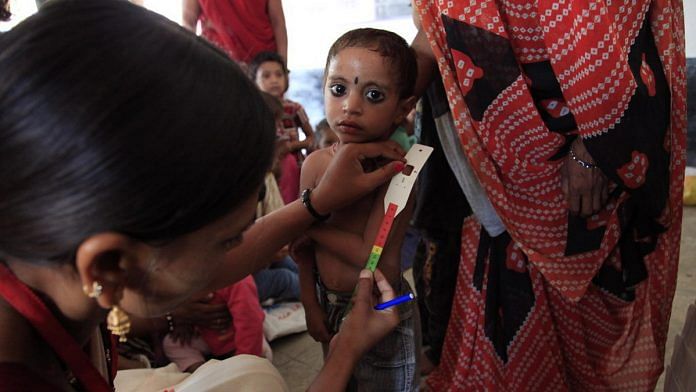New Delhi: States have not utilised even half of the budget allocated for the Narendra Modi government’s flagship programme to improve nutritional outcomes, POSHAN Abhiyaan, the NITI Aayog has noted in a report prepared before its sixth governing council meeting, chaired by the PM last week.
Central health insurance scheme Ayushman Bharat could also miss its key target of operationalising 1.5 lakh health and wellness centres (HWCs) by December 2022, which is also being implemented by the states.
ThePrint reached Dr V.K. Paul, Member (Health), NITI Aayog, through calls and text messages for a comment on the findings, but there was no response until the time of publishing this report.
POSHAN Abhiyaan progress ‘not encouraging’
According to the 162-page document, the progress of the POSHAN Abhiyaan is “not encouraging”. It noted issues with the scheme that needed “attention”, and added: “Fund utilisation under the scheme is at 40 per cent against the released amount of Rs 5,045.6 crore; states have utilised Rs 2,057.4 crore since 2017.”
In chapter 6 of the report, titled ‘Health and Nutrition’, the NITI Aayog stressed the agenda to “intensifying the implementation of programmes for improving nutritional status”.
While vacancies continue to hinder the performance of the POSHAN scheme, only nine states and union territories have so far sanctioned posts for State Programme Management Units (SPMU). The report also recognised that the problem of under-nutrition, stunting, and wasting is serious in India.
The report quoted the recently released National Family Health Survey 5, which showed that children in several states are more undernourished now than they were five years ago, and noted a rise in prevalence in the nutrition outcome indicators of stunting, wasting, and being underweight in children, and a rise in anaemia across all age groups.
“One in two women of reproductive age is anaemic. This calls for an urgent action to create synergy between the various programmes to ensure efficient and effective delivery for outcomes,” it noted.
It also said that “states continue to struggle with the procurement of smartphones and growth monitoring devices, with an overall coverage of 58 per cent for smartphones, 67 per cent for infantometer (which is used to measure children’s size); 66 per cent for stadiometer (which measures height); 72 per cent for weighing scale (infants), 71 per cent for weighing scale (mother and child).”
Also read: Modi’s POSHAN Abhiyan unlikely to make India malnutrition-free by 2022: CSE report
Ayushman Bharat could miss target
The NITI Aayog further noted that the Modi government’s flagship scheme Ayushman Bharat could miss its target of operationalising 1.5 lakh health and wellness centres (HWCs) by December 2022, if it doesn’t pick up the pace.
The health insurance scheme Ayushman Bharat has two pillars. One is Health and Wellness Centers (AB-HWCs) for providing comprehensive primary healthcare services and the other is Pradhan Mantri Jan Arogya Yojna (PMJAY) to provide financial protection for secondary and tertiary care to about 40 percent of India’s households.
According to the report, “as of 3 February 2021, there are 58,196 HWCs in India, a little over 30 per cent of the target. At this rate, it is difficult to operationalize 1.5 lakh HWCs by December 2022”.
In a sub-head titled ‘Expediting operationalisation of Ayushman Bharat Health and Wellness Centres’, it pointed out: “States like Maharashtra and Punjab have been able to convert 60 per cent of their facilities into HWCs whereas Rajasthan, Kerala, and Bihar still lag in achieving their target with less than 15 per cent of HWCs converted.”
The think-tank added that most of the union territories except Delhi and Ladakh have converted a higher share of their facilities into HWCs.
It concluded by advising: “To reach this target, all the states need to address the HR (human resource) gaps and make efforts for ensuring all the 12 packages of services, including availability of free medicines and diagnostics, tele-consultations through e-Sanjeevani… quality accreditation of these centres and promoting the establishing and strengthening the Jan Arogya Samitees.”
Also read: Only 8 Ayushman Bharat packages cover care for terminally ill patients, govt analysis finds
How to spot outbreaks earlier
According to the NITI Aayog, the inability to predict an outbreak, the lack of uniformity in outbreak investigation and the higher number of vacant seats make India’s disease surveillance mechanism weak.
It recognised that public health surveillance is “not a priority” in many states, but the Covid-19 pandemic has highlighted its importance.
“States need to focus on timely information and measures therein, ensuring universalisation of Integrated Health Information portals and to strengthen surveillance in urban and municipal areas also,” the report said, adding that “there is no uniformity in outbreak investigation and reporting and there are limitations in geographic coverage”.
It also called for vacancies in the Indian Disease Surveillance Programme to be filled, highlighted how HWCs can strengthen community-based surveillance for non-communicable and communicable diseases, and called for an increase in expenditure on health through private and PPP projects using the government’s Viability Gap Funding (VGF) scheme.
‘Immediate attention needed’
Dr Anant Bhan, researcher and trainer in the field of public health, global health and bioethics, said both POSHAN Abhiyaan and Ayushman Bharat are critical schemes that need immediate attention.
“POSHAN Abhiyaan is one of the critical schemes for providing nutrition to children and women. Failure of the scheme can cause long-term damage and can have several societal and economic repercussions,” Bhan told ThePrint.
“Announcement of Health and Wellness Centres under Ayushman Bharat was one of the major reforms done in primary healthcare. They should be made functional only with adequate infrastructure and skilled human resources,” he added.
Also read: Ayushman Bharat wasn’t a ‘boon for migrants’ under lockdown, govt data shows






